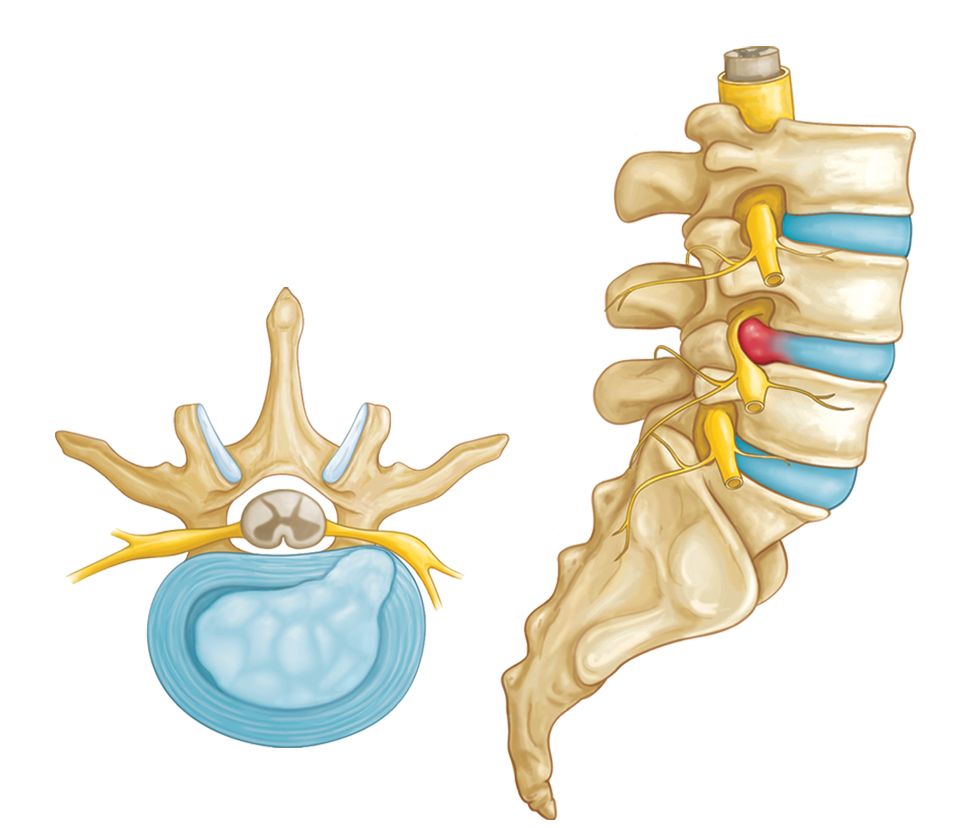The most common cause of lumbar disc hernia is lower back pain along with leg pain that interferes with day to day activities. Most of the disk herniation occurs between the fourth and fifth lumbar vertebrae. It also occurs within the fifth lumbar vertebrae and first sacral vertebra.
Anatomy-
The lumbar spine is consisting of 5 vertebrae, located in the lower back portion. Within each of the 5 vertebrae, there is a tough fibrous pad that absorbs shock. This shock-absorbing fibrous pad is well known as a disc. Each disc contains an annulus fibrosis that covers the nucleus pulposus (a gel-like substance).


Spinal disc herniation takes place when there is a break or cracks in the annulus fibrosis, permitting the nucleus pulposus to come out. This causes a lumbar herniated disc. It is also known as a ruptured disc or bulging disc.
During herniation, the disc compresses the spinal nerves or spinal cord. The nerves
branch out from the spinal cord through a small passage between the discs and the
vertebrae. The herniated disc presses the nerve in that passage and this leads to
tremendous pain associated with lumbar disc hernia.
Causes of Lumbar Disc Hernia-
Lumbar Disc Hernia is generally caused due to the change in the normal disc
structure. Mostly, this hernia arises due to ageing and break down of the discs. A
severe injury in the normal disc can leads to lumbar disc hernia.
Symptoms- Lumbar Herniated Disc
- Leg Pain-
Leg pain is comparatively worse than lower back pain. If the pain diffuses throughout
the large sciatic nerve in the back portion of the leg, it is generally termed as sciatica
or radiculopathy. - Nerve Pain-
The most notable symptom is usually known as nerve pain. This pain in the leg is
generally described as piercing, electric, searing, radiating, or searing. - Different Position of the Symptoms- Based on the positions such as herniation degree and where the disc herniates, you can experience severe pain. Depending on the position, the symptoms may occur in the buttock, calf, low back, foot or toes, back, or front side of the thigh.
- Neurological Symptoms- Certain neurological symptoms are been seen in the foot or leg or toes.
The symptoms are as follows:
- Numbness
- Pins and needles feeling
- Weakness
- Tingling
- Foot Drop
Spinal Disc Herniation in the lumbar region shows some neurological symptoms like
difficulty in lifting the foot while walking. It also becomes difficult to stand on the
foot’s ball. This condition is generally known as foot drop.
Lower Back Pain-
This lower back pain is generally described as throbbing or dullness and followed by
stiffness. The lower back muscle spasm is generally due to disc hernia that can
alleviate by taking rest for a day or two or sitting in a recliner. The pain may also
alleviate by applying heat or ice or lying flat on the back and keeping a cushion under
the knees.
- Tremendous Pain With Movement-
The pain may occur due to prolonged sitting or standing. It may even occur just by
walking a short distance. A sneeze or laugh or any other action can increase the pain.


SOURC: pickup from neuro_lumb-lam_anat_1a_layers.psd
Doctor Examination-
Medical History and Physical Exam
- X-ray
An X-ray is simply a test that uses electromagnetic waves of high energy and short
wavelength. These waves generate images of internal bones, organs, and tissues onto a
film.
- Magnetic Resonance Imaging (MRI)-
A process that makes a combinational use of radio frequencies, a computer, and large
magnets. MRI generates precise images of structures and organs inside the body. - Myelogram-
In this process, a dye is usually injected into the spinal cord to get a cleary image on
X-rays. - Computed Tomography Scan (CT or CAT Scan)-
An imaging process uses computer-based technology and X-rays. With these, it
generates axial and horizontal images. The images of CT scans are more detailed in
comparison to general X-rays and are useful when bony pathology is suspected.


Treatment- Non-surgical Treatment
- Medications and Cold Therapy- After an injury, physicians may suggest medications and cold therapy. During the first 1 day to 2 days, cold therapy reduces muscle spasm, pain, inflammation, and swelling by lowering the blood flow. Medications that include anti-inflammatory drugs help to reduce the inflammation and swelling. These drugs act as a pain-killer as well as a muscle relaxant to reduce tremendous pain. Non-steroidal Anti-inflammatory Drugs (NSAIDs) are generally used for mild to moderate pain treatment.
- Spinal Injection- If a person suffers from intolerable leg pain, then the physicians go for epidural steroid injections. This injection places the anti-inflammatory drug into a space that is near to the affected area to reduce the pain.
- Physical Therapy- A physician may recommend physical therapy to reduce pain and improve flexibility.
Some examples of this therapy are ice and heat therapy, stretching, pelvic traction, and gentle massage.
Surgical Treatment-
If there is no result from non-surgical treatment then spine surgery is generally suggested. Constant leg weakness, pain, or function loss needs further evaluation. It is too rare to see that lumbar disc hernia causes bowel or bladder incontinence and groin or genital numbness. If these symptoms arise then it needs immediate medical treatment. Generally, discectomy is generally done but sometimes laminotomy is also done.
With the use of minimally invasive techniques, this process is usually done. Minimally invasive spine surgeries do not need large incisions. During operation, there is a need for small specialized devices and instruments like a microscope, endoscope.
Nearly 80% of people suffer from the episode of lower back pain once in their lifespan. So, if you feel any symptom related to lumbar disc hernia, then start taking precautions at the earliest. Participating in daily exercises, maintaining a proper weight and diet can lower the risk of this disease.
